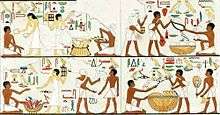Deben (unit)
| Deben[1] (w/"stone-block"–O39) (as determinative) (horiz. water-N) in hieroglyphs |
|---|
The deben was an ancient Egyptian weight unit.
Old and Middle Kingdom

Stone weights from the Old Kingdom have been found, weighing about 13.6 g (0.48 oz; 0.44 ozt). Similar weights from the Middle Kingdom were discovered at Lisht. From the Middle Kingdom date also deben weight units used for metals, referred to as copper deben and gold deben, the former being about twice as heavy (23.7 g (0.84 oz; 0.76 ozt)) as the latter.
New Kingdom
From the New Kingdom one deben was equal to about 91 g (3.2 oz; 2.9 ozt). It was divided into ten kidet (alt. kit, kite or qedet),[2] or into what is referred to by Egyptologists as 'pieces', one twelfth of a deben weighing 7.6 g (0.27 oz; 0.24 ozt).[3] It was frequently used to denote value of goods, by comparing their worth to a weight of metal, generally silver or copper.
Protocurrency
It has been speculated that pieces of metal weighing a deben were kept in boxes,[4] taken to markets,[5] and were used as a means of exchange.[6] Archaeologists have been unable to find any such standardized pieces of precious metal. On the other hand, it is documented that debens served to compare values. In the 19th Dynasty, a slave girl priced four deben and one kite of silver was paid for with various goods: 6 bronze vessels, 10 deben of copper, 15 linen garments, a shroud, a blanket, and a pot of honey.[7]
Legacy
Debens appeared in the computer game Pharaoh as its currency (in the form of gold).
References
- Allen, James P. (2000). Middle Egyptian: An Introduction to the Language and Culture of Hieroglyphs. Cambridge, UK: Cambridge University Press. p. 101. ISBN 0-521-77483-7.
- Robert Steven Bianchi, Daily Life of the Nubians, Greenwood Press 2004, ISBN 0-313-32501-4 p.270
- Iorwerth Eiddon Stephen Edwards, The Cambridge Ancient History, Cambridge University Press 1973, ISBN 0-521-08230-7, p.389
- George A. Reiser, "The Household Furniture of Queen Hetep-heres I", BMFA 27, No. 164, December 1929, pp. 83-90
- R. Lepsius, Denkmäler aus Aegypten und Aethiopien, Abth. II, Bl.96
- T. G. H. James, Pharaoh's People: Scenes from Life in Imperial Egypt, Tauris Parke Paperbacks 2007, ISBN 1-84511-335-7, p.245
- Iorwerth Eiddon Stephen Edwards, The Cambridge Ancient History, Vol 2, pt 1, Cambridge University Press 1973, ISBN 0-521-08230-7, p.390